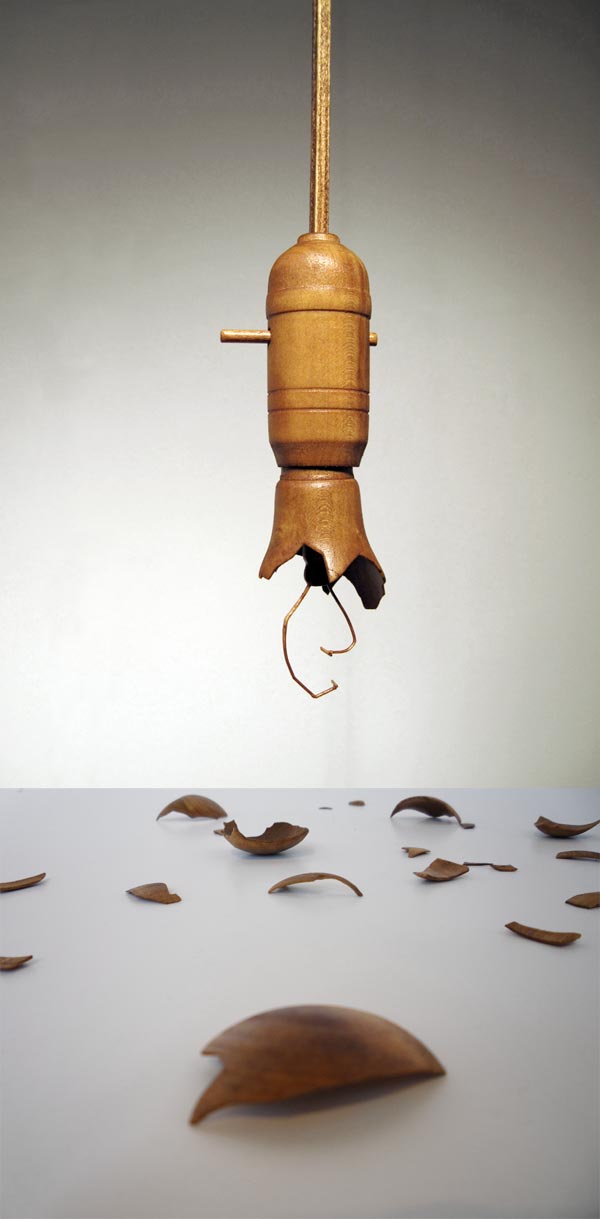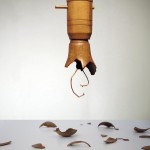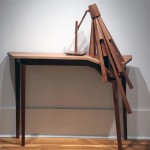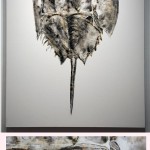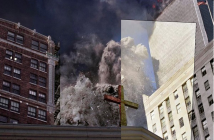ON THE INTANGIBLE: SHEILA GALLAGHER & DARREN FOOTE
Darren Foote is a very calm guy. He speaks in measured tones and never gets too excited. Sheila Gallagher is an energetic flurry of ideas and excitement. The pairing of their work for the two-person exhibition "ASTRA CASTRA" at Judi Rotenberg Gallery is a powerful blending of their individual explorations of spirituality and notions of the intangible. We sat down for dinner and conversation at Audubon to discuss the intangible, the spiritual, and capital letters.
MN: Darren, let's start with you and talk about the origins of your work.
DF: I think that it would be wrong for me to say that this didn't start with Bernini, and basically my desire to remake his sculptures in my own way. But I think growing up in Idaho and being apart from my immediate peer group, who were mostly Mormon, I feel like I was given this different status and I have often considered the bigger picture from this outsider perspective. I've always had this kind of observational experience as an artist.
MN: Is it about making the spiritual physical?
DF: Absolutely. I think a lot of it is my love of what Bernini was doing, but also my love of what the Realists were doing in France, artists like Courbet and others. Infusing the common and the everyday with a sense of divinity. A lot of pieces that I showed at the Rhys Gallery were about that, these very common, everyday scenarios infused with this divinity.
MN: I feel like this is thematic in both of these bodies of work. You are making the intangible tangible, while Sheila, you are using smoke, a sort of intangible element, and you're using it to render the tangible. How do you see these things relating? Is smoke an equivalent to Darren's idea of spirituality, or is it something altogether different?
SG: Interesting, I hadn't thought about the smoke as analogous to making the light manifest... but I do think there is an analogy there. One of the reasons I like working with smoke is that it's totally crazy and chaotic. You can mine it for all of its metaphors: a sort of ephemerality, intangibility, transience. It's the stuff of ritual, it's violent, and it's uncontrollable. It's visible but immaterial, and there's not that much stuff on earth which is visible yet immaterial. Light is another one...
In this show, the smoke is used to render these highly representational forms of the horseshoe crab and the sea urchin, which I chose specifically because they have both been on earth for more than 250 million years. Especially the sea urchin, which has this rigorous geometry that I wanted to relate to the mandala.
Also, the smoke is used in the video as this thing that keeps on going, it's insistent in its upwardness. That smoke in the video is going in real time.
MN: Had you two been in conversation about the bodies of work you were doing, leading up to this show?
SG: No. We would see each other and say that we were up to something.
DF: We tried, but there was also this sort if inherent relationship, we felt like we didn't really need to collaborate.
SG: I had no doubts, and totally trusted that the associations and connections would be made once the show was up, and they are. I think they are.
MN: Within this idea of making the intangible become tangible, one of the pieces I find most striking in the show is Darren's piece of the broken lightbulb. It is really a manifestation of the end of your line of thought, but it is made by the same processes as the rest of your pieces, so it exists in the world of your other pieces but at the same time is a denial of that world. Where did that come from?
DF: That piece, like you said, was very much the end of that line of thought. I knew I was going to make that piece a long time ago as the end of this body of work. I think that it works on its own, but it also does work within the context of the body of work as the end. That's totally where it came from, it was about drawing a boundary around this line of thought.
I that that there are a lot of things you can say about light -- small-l light or capital-L Light in the spiritual sense. It could just be that I'm very pessimistic about Light, it is subject to the same laws we are.
SG: When I think of Light -- capital-L -- this comes from growing up Catholic, I think about light as an ocular metaphor for understanding. You need light to see, it is seeing, it is understanding. So it's pessimistic to me because when I think about how light fails, when it isn't accessible, I think of that as the inability to understand. Denying light denies the tools for understanding.
MN: Is this an endgame for you? Have you arrived at some point where you know enough to know that you don't know anything?
DF: I think that I've given myself the out, because I am such a maker and so devoted to the Object -- capital O.
MN: We only talk in capital letters at this table.
DF: My interest, and what I'm creating, are these artistic renditions of these events and scenarios. So, I'm making them. I'm not saying that this is the actual thing, I'm saying that this is the artist's version of this event.
MN: Is your work the anti-readymade?
DF: That piece is, certainly more than any other I've ever made. I guess it is, but I don't see it that way. I'm not breaking a bulb in my studio and then re-creating it. I'm working from a different place, and coming at it backwards.
SG: How do you make all those little shards? They're really nice! We've been in a few interviews now, and you've never addressed how you make those. You are mister Maker with a capital-M, and they are these lovingly crafted, fetishistic shells.
DF: Yes. They took a lot of time. That one is the result of about eight attempts at making a bulb. The actual bulb that you see broken, the one hanging there, is the first one, believe it or not! It was the first attempt. The shards were the hardest. Just trying to turn those pieces on my lathe was profoundly difficult.
MN: Earlier, you mentioned the mandala. How do you see that piece relating to the other pieces in the show, like the smoke pieces and Darren's work?
SG: When Abi and Kristen asked if I would be interested in doing a two- or three-person show on art and spirituality, I was really excited. But at that point, I had just been coming through this grueling, ten-year process and I was feeling zip for spirituality, no juices going.
So the work in this show came out of the obstacles to an interior life, where the everyday collides with the desire for spiritual experience. With the mandala, one of the things I am really interested in is how, in our lives, we are always running up against these different types of time. There is eternal time, and instant-messaging time... if you walk along the beach, there is a sea urchin, or if you go to the Arnold Arboretum and see the magnolia, that's dinosaur time! We co-exist with these different types of time, and time has always been my enemy, as anyone who knows me can attest.
The kalachakra mandala in the show is specifically about time. This is not a suggestion, or kind of maybe the idea of a mandala, this is the actual thing. It was very rigorous to make. So this kalachakra mandala is made of of over twenty years of scans of my appointment books, where my life is basically divided into fifteen minute increments, inside of this very rigorous geometric structure.
MN: We started off talking about the ephemeral, and the intangible. This notion of time seems very related to that.
SG: Oh, I completely agree. I think that time is the most important element here. I think that time is the major theme of the show.
DF: Definitely. Time, with a capital-T.
- Darren Foote, Bulb, (details) poplar wood, 2009.
- Darren Foote, Entry Table, sapele and polycrylic, 2008.
- Sheila Gallagher, Horseshoe Crab, (full canvas and detail below) smoke on canvas, 2009.
"ASTRA CASTRA" is on view February 5 - March 1, 2009 at judi rotenberg gallery.
All images are courtesy of the artist and insert venue name.

